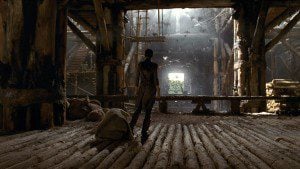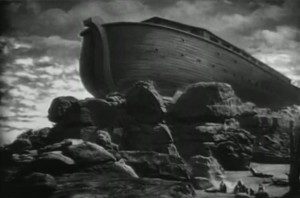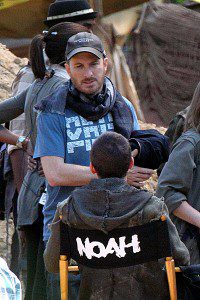Thanks to a generous e-pal, I have finally seen Noah’s Ark (1928), and it’s a hoot. This semi-silent, semi-talkie Bible epic has never, to my knowledge, been released on video, but it has been shown on Turner Classic Movies, which is where my e-pal taped his copy.
Written by Darryl F. Zanuck (who went on to create 20th Century Fox) and directed by Michael Curtiz (who went on to direct everything from Casablanca to King Creole), this film was clearly influenced by Cecil B. DeMille’s The Ten Commandments (1923). Both films are divided almost in half between a biblical story and a modern-day story. Both films feature modern characters who mock the very notion of God and are then “punished”, directly or indirectly, for their skepticism. And the Noah movie even turns its protagonist into a sort of Moses figure, by using motifs from the earlier biblical and cinematic versions of the Moses story.
Two particularly striking clips from Noah’s Ark will give you a sense of what I’m talking about. First, the prologue:
http://www.youtube.com/watch?v=8BzUEDIqNgc
Click here if the video file above doesn’t play properly.
Note the Golden Calf sequence. And note how the focus, in the Tower of Babel sequence, is on the slaves being forced to work for the taskmasters — just as the Hebrews were forced to work for the Egyptians in DeMille’s film. This is different from, say, John Huston’s The Bible: In the Beginning… (1966), or even the Book of Genesis itself, where the focus is on the people who arrogantly believe that they can reach up to God by building the Tower.
Also, you get a hint here of how Noah’s Ark reverses the structure of The Ten Commandments. DeMille’s film begins with the biblical story, and then follows it with the modern story, which in turn climaxes with a flashback that gives us a brief glimpse of one of Jesus’ miracles; whereas Curtiz’s film invokes Jesus at the end of its prologue, then tells the modern story, and then tells the biblical story. (I am struck, incidentally, by this film’s negative portrayal of the stock market — just one year before the Crash of ’29.)
When the film finally gets to the highly-embellished story of Noah himself, it adds a few more Mosaic elements — the mountain, the burning bush — as well as giant tablets with flaming letters that could have come straight out of DeMille’s movie. But then Curtiz does something extra with the imagery that I find endearingly goofy. And then the film throws in a line from the Lord’s Prayer! It’s quite the interesting mix of biblical and cinematic allusions.
http://www.youtube.com/watch?v=cuzS9JyQdpI
Click here if the video file above doesn’t play properly.
JUN 14 UPDATE: Matt Page posted an interesting and historically informed review of the film today at his Bible Films Blog.












